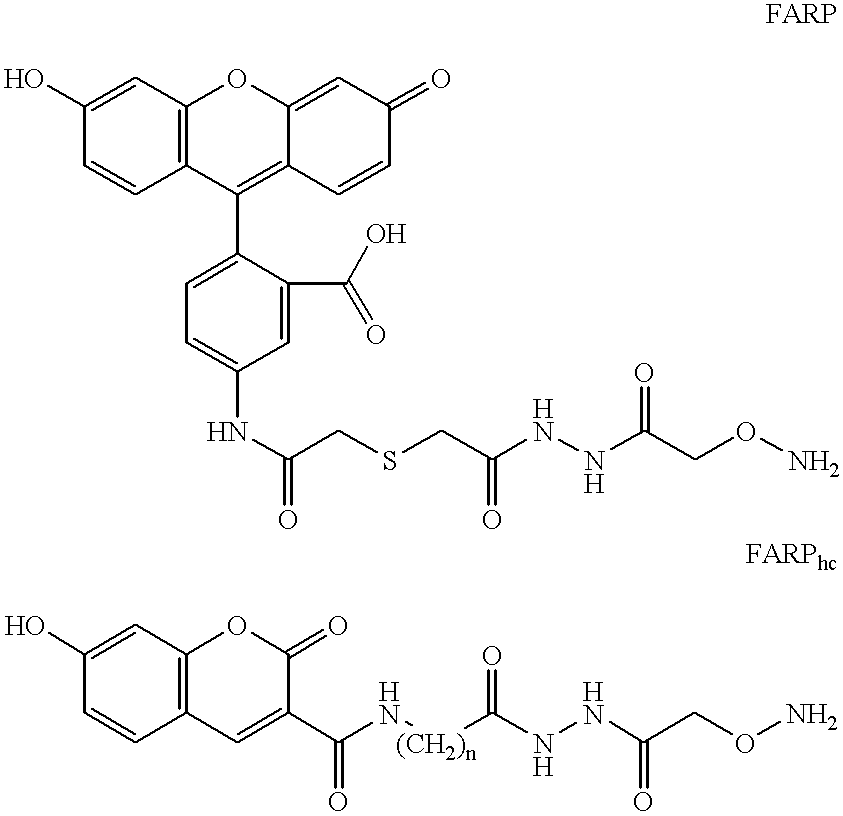Method for identifying mismatch repair glycosylase reactive sites, compounds and uses thereof
a glycosylase and reactive site technology, applied in the field of mismatch repair glycosylase reactive site identification, can solve the problems of severe limitation, essentially restricted gel-electrophoresis-based methods, and mutations in those other genes that are likely not to be identified, so as to shorten the time required to screen tumor samples and improve cost-effectiveness
- Summary
- Abstract
- Description
- Claims
- Application Information
AI Technical Summary
Benefits of technology
Problems solved by technology
Method used
Image
Examples
example 2
BARP-Based Detection of Mismatches Formed via Self-Complementation of Single-Stranded M13 DNA
Samples of M13 single stranded DNA that contain approximately 1 MutY-recognizable mismatch per 2,500 bases were treated with MutY to generate aldehyde-containing reactive sites appropriate for reaction with BARP. Nominal gel electrophoretic studies as well as BARP-based chemiluminescent studies were then preformed. Control samples used were: Single stranded M13 without enzymatic treatment; Double stranded M13 DNA without any mismatches and no enzyme treatment; and double stranded M13 DNA without mismatches and enzyme. FIG. 8 (A and B) shows the results of both methods of detection. FIG. 8A (luminescence studies) show that only when mismatches are present (single stranded M13) and MutY is used is there a chemiluminescence signal. In agreement, gel electrophoresis (FIG. 8B) shows cuts in M13 are only generated under the same conditions. It can be seen that there is good agreement among the two...
example 3
Detection and Isolation of DNA Containing Base-Substitution Mutations: Detection of a Single A-To-C Transversion Engineered in a P53 Gene within a 7091-Long Plasmid
The ability of the present technology (A.L.B.U.M.S) to detect base mismatches (demonstrated in previous examples) is directly applicable to detection of base substitution mutations. For example, a standard procedure to generate mismatches at the positions of mutations in DNA, is to mix mutation-containing DNA with wild-type DNA. Upon heating and re-hybridization of the mixture, heteroduplexes with mismatches are generated at the positions of mutations (FIG. 1), which can then be detected with high sensitivity and specificity as demonstrated in example 1.
To isolate mutation-containing DNA from normal DNA, following BARP-labeling of the generated aldehydes at positions of mismatches (FIG. 1) the DNA is immobilized on neutravidin-coated microplates, followed by exhaustive washing to remove the homoduplex DNA. As a result, on...
example 4
Comparison of Small Versus Large Ligand Compounds in Binding to MutY- or TDG-Generated Reactive Sites in DNA: Synthesis and Advantage of AED Versus BARP and FARP. Chemiluminescence Signals by AED.
(a) To synthesize AED, O-(Carboxymethyl)hydroxylamine hydrochloride was conjugated to ethylenediamine (Aldrich) in distilled water using 1-Ethyl-3-[3-(dimethylamino)propyl] carbodiimide (EDAC) as the coupling reagent. An 100-fold excess of ethylenediamine over O-(Carboxymethyl)hydroxylamine hydrochloride was utilized during the reaction to allow preferential coupling of ethylenediamine to the carboxyl groups. The conditions for the catalysis of this reaction by EDAC is well known to those skilled in the art. TLC analysis and purification on silica gel with CHCl.sub.3 :CH.sub.3 OH:CH.sub.3 COOH in a 70:20:5 ratio indicated the product at an R.sub.f of 0.2-0.25. The certificate of analysis provided 1H NMR data consistent with the AED structure provided earlier.
(b) The ability of hydroxylamine...
PUM
| Property | Measurement | Unit |
|---|---|---|
| Molecular weight | aaaaa | aaaaa |
| Fluorescence | aaaaa | aaaaa |
Abstract
Description
Claims
Application Information
 Login to View More
Login to View More - R&D
- Intellectual Property
- Life Sciences
- Materials
- Tech Scout
- Unparalleled Data Quality
- Higher Quality Content
- 60% Fewer Hallucinations
Browse by: Latest US Patents, China's latest patents, Technical Efficacy Thesaurus, Application Domain, Technology Topic, Popular Technical Reports.
© 2025 PatSnap. All rights reserved.Legal|Privacy policy|Modern Slavery Act Transparency Statement|Sitemap|About US| Contact US: help@patsnap.com



